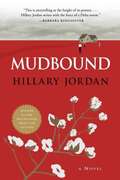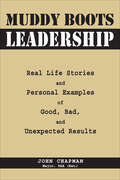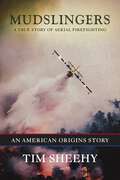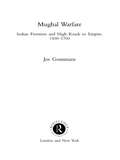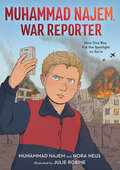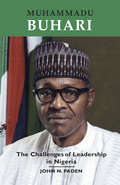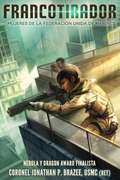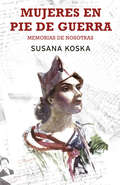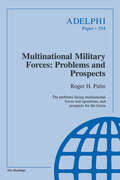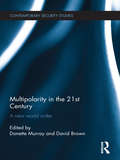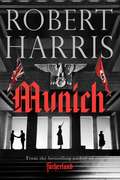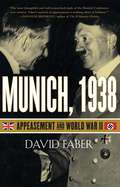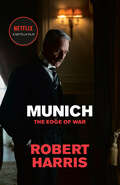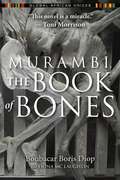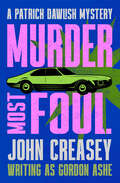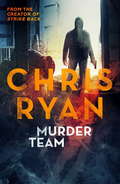- Table View
- List View
Mudbound
by Hillary Jordan<P>Jamie McAllan, Laura's brother-in-law, is everything her husband is not-charming, handsome, and haunted by his memories of combat. <P>Ronsel Jackson, eldest son of the black sharecroppers who live on the McAllan farm, has come home with the shine of a war hero. <P>But no matter his bravery in defense of his country, he is still considered less than a man in the Jim Crow South. <P>It is the unlikely friendship of these brothers-in-arms that drives this powerful novel to its inexorable conclusion. <P>The men and women of each family relate their versions of events and we are drawn into their lives as they become players in a tragedy on the grandest scale.
Mudd in Your Eye (Star Trek: The Original Series #81)
by Jerry OltionAfter millennia of warfare, the planets Prastor and Distrel may have finally achieved a lasting peace. Investigating on behalf of the Federation, Captain Kirk is shocked to find out that the architect of the peace is none other than that notorious con artist, Harcourt Fenton Mudd! Mudd claims to be a changed man, but Kirk has his doubts. He knows that Mudd has to be running some sort of scam, but what is he up to? Kirk must find out soon--before the peace gives way to unending war.
Muddy Boots Leadership: Real Life Stories and Personal Examples of Good, Bad, and Unexpected Results
by John Chapman285 military "leadership situations" and the actions leaders have taken--and some real surprises. Emphasis on practical applications of leadership, coupled with real-life vignettes add the real spark to the leadership lessons learned and relearned by each generation of America's warriors. Applicable to business, corporate, and organizational leadership.
Mudslingers: A True Story of Aerial Firefighting (An American Origins Story)
by Tim SheehyThe unique history of aerial firefighting as seen through the eyes of a pilot, former Navy SEAL, and current owner of one of the most successful aerial firefighting companies in the world.Blending historical context and first-person narrative, Mudslingers tells the dramatic and colorful story of aerial firefighting in America, as seen through the eyes of a decorated former Navy SEAL, US Naval Academy graduate, firefighting pilot, and businessman who founded Montana-based Bridger Aerospace, one of the most successful aerial firefighting teams in the world. Part narrative nonfiction, part memoir, Mudslingers is a riveting account of one person&’s journey from the battlefields of Afghanistan and Iraq to the front lines of a different but no less important battle on the home front—the war against the escalating threat of wildfire. From the early days of the B-17 to the modern fleets of the twenty-first century, Tim Sheehy will take you on a ride through the history of aerial firefighting—the most hazardous and demanding aviation mission in the world. Mudslingers is a rollicking read, an enlightening journey, and a call to action for anyone who believes wildfires are not only one of the greatest threats facing modern civilization but a threat that has long been underestimated, misunderstood, and poorly addressed, despite repeated examples of bravery and innovation by those who choose to do battle with the flames. Indeed, save for a few historic military engagements in the twentieth century, there is not a sustained aviation mission anywhere that comes close to encompassing the danger, precision, and unforgiving nature of aerial firefighting. In telling this story, Sheehy takes readers into the cockpit and into the lives of his fellow pilots—past and present—as they struggle with the seemingly never-ending threat of wildfires. One hundred percent of author proceeds from this book are donated to the Wildland Firefighter Foundation and the United Aerial Firefighters Association.
Mughal Warfare: Indian Frontiers and Highroads to Empire 1500-1700
by J.J.L. GommansMughal Warfare offers a much-needed new survey of the military history of Mughal India during the age of imperial splendour from 1500 to 1700. Jos Gommans looks at warfare as an integrated aspect of pre-colonial Indian society.Based on a vast range of primary sources from Europe and India, this thorough study explores the wider geo-political, cultu
Muhammad Najem, War Reporter: How One Boy Put the Spotlight on Syria
by Muhammad Najem Nora NeusA teenage boy risks his life to tell the truth in this gripping graphic memoir by youth activist Muhammad Najem and CNN producer Nora Neus. &“A story of journalism at its most inspiring, its most heartbreaking, its most essential. Muhammad is a reporter who brings hope to a damaged world.&” —John Berman, CNN anchor &“A powerful true story that demonstrates the power of one young person determined to change the world. Everyone should read this phenomenal book.&” —Victoria Jamieson, coauthor of When Stars Are Scattered &“What an amazing story this is! One family&’s struggle for survival in the chaos of Syria, and one boy&’s courageous decision to risk his life to tell the story. This graphic memoir is inspiring and exciting, powerful and very poignant. I loved it!&” —Anderson Cooper Muhammad Najem was only eight years old when the war in Syria began. He was thirteen when his beloved Baba, his father, was killed in a bombing while praying. By fifteen, Muhammad didn&’t want to hide anymore—he wanted to act. He was determined to reveal what families like his were enduring in Syria: bombings by their own government and days hiding in dark underground shelters. Armed with the camera on his phone and the support of his family, he started reporting on the war using social media. He interviewed other kids like him to show what they hope for and dream about. More than anything, he did it to show that Syrian kids like his toddler brother and infant sister, are just like kids in any other country. Despite unimaginable loss, Muhammad was always determined to document the humanity of the Syrian people. Eventually, the world took notice. This tenderly illustrated graphic memoir is told by Muhammad himself along with CNN producer Nora Neus, who helped break Muhammad&’s story and bring his family&’s plight to an international audience.
Muhammadu Buhari
by John N. PadenThis authorized biography of the current president of Nigeria provides an up-close look at the life of a major ally of the West in the fight against terrorism, poverty, and corruption. The book covers Buhari’s early life and education, his military career, and his brief stint as military of state before he was deposed in a coup. A beacon for democracy in Africa, Buhari is the only Nigerian opposition candidate to be elected to the presidency. The book examines the first year of his presidency, looking at the immense security, economic, and political challenges he faces and the bold moves he is making to tackle them with support at home and abroad.
Mujeres de la Federación Unida de Marines - Francotirador
by Jonathan P. BrazeeDespués de una exitosa gira inicial como fusilero de la Marina, la cabo segundo Gracie Medicine Crow se ofrece como voluntaria para convertirse en francotirador explorador, una de las especialidades militares más mortíferas y peligrosas en el Cuerpo de Marines de la Federación Unida. Gracie proviene de la Nación Apsáalooke, un pueblo con una larga historia de tradición militar. De estatura pequeña y considerada increíblemente bella, es subestimada a menudo, pero eso simplemente la impulsa a ser la mejor francotiradora del Cuerpo. Algo desconfiada de la atención e interacción de sus francotiradores con ella, mantiene lo que considera un frente profesional, pero que no es tan bien recibido por los demás y que le da el sobrenombre de "Princesa de Hielo". Un francotirador técnicamente habilidoso, Gracie siente que su disparo debería hablar por sí mismo. Pero ser un francotirador explorador es mucho más que simple puntería. Si ella quiere una carrera en el Cuerpo, debe aprender no solo el trabajo en equipo, sino también cómo ser una líder de Infantes de Marina. Este es el segundo libro de la serie, pero cada libro es independiente y no tiene que leerse junto con los demás. La serie sigue a dos infantes de marina y a un médico naval mientras siguen sus trayectorias profesionales individuales.
Mujeres en pie de guerra: Memorias de nosotras
by Susana KoskaLa historia oral y política de las españolas del siglo XX. Una emotiva obra coral que también es Historia, compromiso, feminismo, militancia, amor, maternidad, tenacidad y supervivencia. «Desde principio de siglo Mujeres en pie de guerra ha tenido distintas formas: una colección de canciones, escritas por Gabriel Sopeña y Loquillo; una obra gráfica del pintor gallego Fernando Pereira y un documental del mismo título que recorrió ateneos, cine fórums de distinto pelaje, universidades, asociaciones, institutos, festivales nacionales e internacionales e ilustró una incipiente pasión por la recuperación de la memoria histórica. Mujeres en pie de guerra fue un documental en 2004, y aquellos fueron años de búsquedas, encuentros y desencuentros, amor, descubrimientos terribles, cartas, confidencias aterradoras en taxis, en bares, en casas de barrios que desconocía y por los que me perdía siempre. Fotos en blanco y negro de cada una de ellas, una historia enorme, inabarcable. Una crónica sentimental de aquello de "¿Qué fue de los tuyos en la Guerra Civil?" Yo fui sumando y aprendiendo y escuchando y copiando, con vocación de escriba a juzgar por la cantidad de material guardado.»Susana Koska
Mulberry-American: The Artificial Harbor At Omaha
by Major Brett PetersThe Overlord operation is a widely studied episode in military history. Often overlooked is a little known U.S. operation designed to overcome logistical problems in the Overlord plan. For the first 90 days of combat the Overlord operation would not benefit from major ports to sustain the build-up and counter the German attempt to push the Allies back into the sea. The Allies planned, designed, and constructed two artificial harbours to overcome the lack of ports. The harbours were known by the code name, Mulberry. The components were towed across the English channel with the invasion fleet and constructed under enemy fire. Mulberry A, the A stood for American, was completed three days ahead of schedule and doubled the throughput of U.S. supplies over the Normandy beachhead. Mulberry A was destroyed by a summer gale after only three days of operation and subsequently abandoned. Effective beaching LSTs during the operation led many critics to conclude that Mulberry A supply operations had little effect on the Overlord operation. To the contrary, using modern assessment methods, it can be concluded that the Mulberry operation was effective and influenced the outcome of the cross channel attack.
Multidisciplinary Perspectives on Genocide and Memory
by Jutta Lindert Armen T. MarsoobianThis book explores the memory and representation of genocide as they affect individuals, communities and families, and artistic representations. It brings together a variety of disciplines from public health to philosophy, anthropology to architecture, offering readers interdisciplinary and international insights into one of the most important challenges in the 21st century. The book begins by describing the definitions and concepts of genocide from historical and philosophical perspectives. Next, it reviews memories of genocide in bodies and in societies as well as genocide in memory through lives, mental health and transgenerational effects. The book also examines the ways genocide has affected artistic works. From poetry to film, photography to theatre, it explores a range of artistic approaches to help demonstrate the heterogeneity of representations. This book provides a comprehensive and wide-ranging assessment of the many ways genocide has been remembered and represented. It presents an ideal foundation for understanding genocide and possibly preventing it from occurring again.
Multinational Military Forces: Problems and Prospects (Adelphi series #No.294)
by Roger PalinFirst Published in 2005. Routledge is an imprint of Taylor & Francis, an informa company.
Multipolarity in the 21st Century: A New World Order (Contemporary Security Studies)
by Donette Murray and David BrownThis book seeks to help shape the debate surrounding power and polarity in the twenty-first century, both by assessing the likelihood of US decline and by analysing what each of the so-called 'rising powers' can do. As the twenty-first century moves out of its first decade, American supremacy continues to generate intense debate about the nature, quality and sustainability of US power. At the same time, significant developments in four rising powers - China, Russia, India and the European Union – have provoked analysts to ask whether multipolarity is a realistic prospect. Multipolarity in the 21st Century assesses the likelihood of a multipolar world developing, either by a marked US decline and or by the ability of these putative ‘rivals’ to continue to rise to the level necessary to be credibly considered a superpower. Written by a combination of emerging scholars and recognised experts, this volume will provide a timely and authoritative analysis of one of the most controversial and compelling security debates of the twenty-first century. This book will be of much interest to students of Security Studies, Foreign Policy and International Relations in general.
Munich
by Robert HarrisFollowing the success of Conclave comes Robert Harris's new novel, bound for bestseller-dom as he returns to the historical terrain of his best-known book, Fatherland.September 1938Hitler is determined to start a war. Chamberlain is desperate to preserve the peace. The issue is to be decided in a city that will forever afterwards be notorious for what takes place there. Munich. As Chamberlain’s plane judders across the Channel and the Fürher’s train steams relentlessly south from Berlin, two young men travel with secrets of their own. Hugh Legat is one of Chamberlain’s private secretaries, Paul Hartmann a German diplomat and member of the anti-Hitler resistance. Great friends at Oxford before Hitler came to power, they haven’t seen one another since they were last in Munich together six years earlier. Now, as the future of Europe hangs in the balance, their paths are destined to cross again. When the stakes are this high, who are you willing to betray? Your friends, your family, your country or your conscience?
Munich, 1938: Appeasement and World War II
by David FaberOn September 30, 1938, British Prime Minister Neville Chamberlain flew back to London from his meeting in Munich with German Chancellor Adolf Hitler. As he disembarked from the aircraft, he held aloft a piece of paper, which contained the promise that Britain and Germany would never go to war with one another again. He had returned bringing "Peace with honour--Peace for our time." Drawing on a wealth of archival material, acclaimed historian David Faber delivers a sweeping reassessment of the extraordinary events of 1938, tracing the key incidents leading up to the Munich Conference and its immediate aftermath: Lord Halifax's ill-fated meeting with Hitler; Chamberlain's secret discussions with Mussolini; and the Berlin scandal that rocked Hitler's regime. He takes us to Vienna, to the Sudentenland, and to Prague. In Berlin, we witness Hitler inexorably preparing for war, even in the face of opposition from his own generals; in London, we watch as Chamberlain makes one supreme effort after another to appease Hitler. Resonating with an insider's feel for the political infighting Faber uncovers, Munich, 1938 transports us to the war rooms and bunkers, revealing the covert negotiations and scandals upon which the world's fate would rest. It is modern history writing at its best.
Munich: A novel
by Robert HarrisFrom the internationally best-selling author of Fatherland and the Cicero Trilogy--a new spy thriller about treason and conscience, loyalty and betrayal, set against the backdrop of the fateful Munich Conference of September 1938.Hugh Legat is a rising star of the British diplomatic service, serving at 10 Downing Street as a private secretary to the Prime Minister, Neville Chamberlain. Rikard von Holz is on the staff of the German Foreign Office--and secretly a member of the anti-Hitler resistance. The two men were friends at Oxford in the 1920s, but have not been in contact since. Now, when Hugh flies with Chamberlain from London to Munich, and Rikard travels on Hitler's train overnight from Berlin, their paths are set on a disastrous collision course. And once again, Robert Harris gives us actual events of historical importance--here are Hitler, Chamberlain, Mussolini, Daladier--at the heart of an electrifying, unputdownable novel.
Murambi: The Book of Bones
by Boubacar Boris Diop Fiona Mc LaughlinSenegalese author Diop writes fictionalized stories about the 1996 Rwanda ethnic genocide. Over 3 months, approximately 800,000 Tutsis and Twa were killed by Hutu machete massacres. These stories are told from the three groups' perspectives.
Murder Before Evensong: The instant no. 1 Sunday Times bestseller (Canon Clement Mystery)
by Reverend Richard ColesTHE INSTANTLY ICONIC NO. 1 BESTSELLER'Devotees of Midsomer Murders and Agatha Christie's Miss Marple stories will feel most at home here' Guardian'I've been waiting for a novel with vicars, rude old ladies, murder and sausage dogs... et voila!' Dawn French'Cosy crime with a cutting edge' Telegraph'Whodunnit fans can give praise and rejoice' Ian Rankin'Charming and funny' ObserverEven better than I knew it would be' India Knight'Quintessentially English' Sunday Express'An absolute joy' Adam Kay''Wry, tongue-in cheek and whimsical' Daily Mail'Glorious' Robert Webb 'Beautifully written, charming, funny, intelligent and mordant too' Sunday Times'Pitch perfect' Philip Pullman'A cunning whodunnit' Daily ExpressCanon Daniel Clement is Rector of Champton, where he lives alongside his widowed mother - opinionated, fearless, ever-so-slightly annoying Audrey - and his two dachshunds, Cosmo and Hilda.When Daniel announces a plan to install a lavatory in the church, the parish is suddenly (and unexpectedly) divided: as lines are drawn, long-buried secrets come dangerously close to destroying the apparent calm of the village.And then Anthony Bowness - cousin to Bernard de Floures, patron of Champton - is found dead at the back of the church. As the police moves in and the bodies start piling up, Daniel is the only one who can try and keep his community together... and catch a killer.
Murder Between the Lines (Kitty Weeks Mystery)
by Radha Vatsal"I really and truly could not put it down... Vatsal succeeds once again!"—Susan Elia MacNeal, New York Times-bestselling author of the Maggie Hope seriesIntrepid journalist Kitty Weeks returns in the second book in this acclaimed WW1-era historical mystery series to investigate the death of a boarding school student. When Kitty's latest assignment for the New York Sentinel Ladies' Page takes her to Westfield Hall, she expects to find an orderly establishment teaching French and dancing—but there's more going on at the school than initially meets the eye.Tragedy strikes when a student named Elspeth is found frozen to death in Central Park. The doctor's proclaim that the girl's sleepwalking was the cause, but Kitty isn't so sure.Determined to uncover the truth, Kitty must investigate a more chilling scenario—a murder that may involve Elspeth's scientist father and a new invention by a man named Thomas Edison.For fans of Jacqueline Winspear and Rhys Bowen, Murder Between the Lines combines true historical events with a thrilling mystery.Additional Praise for Murder between the Lines:"Vatsal's combination of a feisty protagonist with a tumultuous, fast-changing era remains a winning formula."— Publisher's Weekly
Murder Game
by Christine FeehanView our feature on Christine Feehan’s Murder Game.The new GhostWalker novel from the #1 New York Times bestselling author Christine Feehan. As bodies pile up, a violent new cross-country game is blamed on the GhostWalkers. To clear their name, they infiltrate the dangerous sport. And to survive it, they must ignore the rules.
Murder Most Foul (The Patrick Dawlish Mysteries)
by Gordon AsheThere&’s little chance for R & R during World War II when you have the reputation of British sleuth Patrick Dawlish. A Hampshire country inn seems the perfect place to unwind for Captain Patrick Dawlish and his fiancée, Felicity, as World War II rages on. But all play and no work make Dawlish a bored man. Luckily for him, he&’s never been able to dodge trouble when foul play is afoot . . . A man as big as Dawlish rarely goes unnoticed, which appears to be the case when he senses someone watching him. That man is soon murdered by someone wearing Dawlish&’s stolen uniform. Instead of a peaceful week away from the Home Defence Army, Dawlish finds himself the prime suspect in a murder. What better way to keep him from investigating what&’s really going on? To make matters even more complicated, there&’s a guest at the inn under suspicion for being a spy—with ties to Nazi Germany . . .
Murder Most Malicious (A Lady and Lady's Maid Mystery #1)
by Alyssa Maxwell&“Downton Abbey fans will enjoy Maxwell&’s evocative descriptions&” of British post-WWI society in the first Lady and Lady&’s Maid Mystery (Library Journal). December 1918: As a difficult year draws to a close, there is much to celebrate for nineteen-year-old Phoebe Renshaw and her three siblings at their beloved family estate of Foxwood Hall. The dreadful war is finally over; eldest daughter Julia&’s engagement to their houseguest, the Marquis of Allerton, appears imminent; and all have gathered to enjoy peace on earth, good will toward men. But the peace of Foxwood Hall is shattered on the morning of Boxing Day, when the Marquis goes missing. Not entirely missing, however, as macabre evidence of foul play turns up in gift boxes given to lady&’s maid Eva Huntford and a handful of others. Having overheard her sister and the Marquis in a heated exchange the night before, Lady Phoebe takes a personal interest in solving the mystery. As the local constable suspects a footman at Foxwood Hall, Phoebe and Eva follow the clues to a different conclusion. But both young women will need to think outside the box to wrap up this case—before a cornered killer lashes out with ill will toward them . . . &“A super-fun read featuring Lady Phoebe Renshaw and her lady&’s maid, Eva, as they put aside their society roles to risk their necks in order to catch a killer.&”—Suspense Magazine &“Details of the lives of the nobility and their servants, and the aftermath of the war, are woven throughout the story, and the forward-thinking Phoebe is a charming main character.&”—Booklist
Murder Team: The lone wolf on an unofficial mission
by Chris RyanDanny Black is a lone wolf on an unofficial mission.He is in the deserts of East Africa looking for his old comrade in arms Spud, wounded in their last mission and now missing.A wounded British solder is a commodity in these parts...Danny recruits a grizzled ex-Blade to help him, encounters an ex-Mossad mercenary, who is part of the supply chain, and heads for a showdown with a small Somali army, led by most-wanted Islamist militant Abu Bakr.In the heat of battle Danny discovers, he is not the lone wolf he thought he was. He begins to wonder, as so many soldiers have before him, is he just a pawn in a greater game?
Murder Team: The lone wolf on an unofficial mission
by Chris RyanDanny Black is a lone wolf on an unofficial mission. He is in the deserts of East Africa looking for his old comrade in arms Spud, wounded in their last mission and now missing. A wounded British solder is a commodity in these parts... Danny recruits a grizzled ex-Blade to help him, encounters an ex-Mossad mercenary, who is part of the supply chain, and heads for a showdown with a small Somali army, led by most-wanted Islamist militant Abu Bakr. In the heat of battle Danny discovers, he is not the lone wolf he thought he was. He begins to wonder, as so many soldiers have before him, is he just a pawn in a greater game?
Murder Team: The lone wolf on an unofficial mission
by Chris RyanDanny Black is a lone wolf on an unofficial mission.He is in the deserts of East Africa looking for his old comrade in arms Spud, wounded in their last mission and now missing.A wounded British solder is a commodity in these parts...Danny recruits a grizzled ex-Blade to help him, encounters an ex-Mossad mercenary, who is part of the supply chain, and heads for a showdown with a small Somali army, led by most-wanted Islamist militant Abu Bakr.In the heat of battle Danny discovers, he is not the lone wolf he thought he was. He begins to wonder, as so many soldiers have before him, is he just a pawn in a greater game?(P)2015 Hodder & Stoughton
